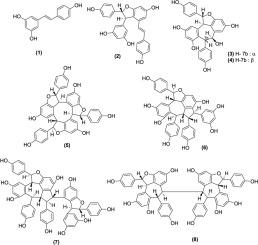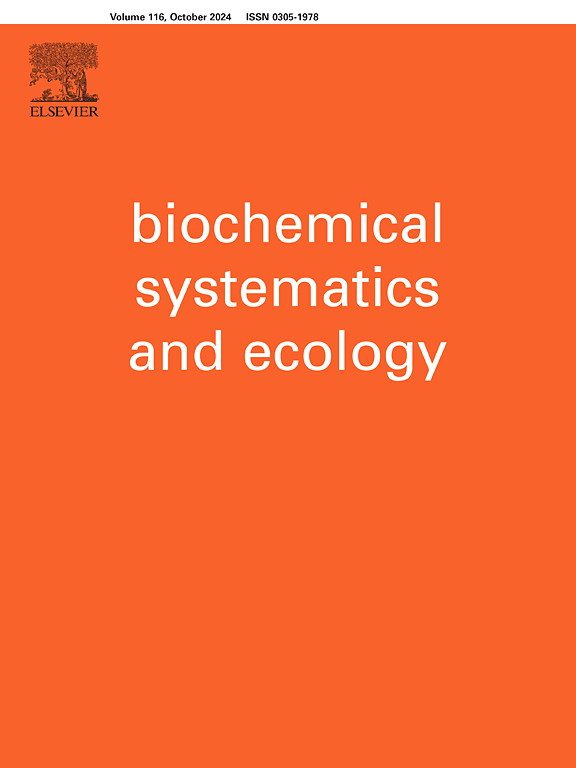Natural products and chemotaxonomic studies from the twigs of Neobalanocarpus heimii (King) P.S. Ashton (Dipterocarpaceae, Malvales)
IF 1.4
4区 生物学
Q4 BIOCHEMISTRY & MOLECULAR BIOLOGY
引用次数: 0
Abstract
Neobalanocarpus heimii is one of the toughest timbers in the world and resistant to termites and fungi. Phytochemical investigation from the twigs of N. heimii led to the isolation of eight resveratrol oligomers namely trans-resveratrol (1), (−)-ε-viniferin (2), balanocarpol (3), ampelopsin A (4), (+)-α-viniferin (5), vaticanol A (6), vaticanol B (7) and hopeaphenol (8). The structures of the isolated compounds were successfully elucidated using various spectroscopic techniques as well as comparison with the literature data. The chemotaxonomic significance of the isolated compounds was summarized, along with a compound-genus network analysis.

Neobalanocarpus heimii (King) P.S. Ashton (Dipterocarpaceae, Malvales) 小枝的天然产物和化学分类学研究
楠木是世界上最坚硬的木材之一,对白蚁和真菌有很强的抵抗力。通过对 N. heimii 树枝进行植物化学研究,分离出八种白藜芦醇低聚物,即反式白藜芦醇 (1)、(-)-ε-viniferin (2)、balanocarpol (3)、ampelopsin A (4)、(+)-α-viniferin (5)、vaticanol A (6)、vaticanol B (7) 和 hopeaphenol (8)。利用各种光谱技术以及与文献数据的比较,成功地阐明了所分离化合物的结构。通过化合物-属网络分析,总结了所分离化合物的化学分类学意义。
本文章由计算机程序翻译,如有差异,请以英文原文为准。
求助全文
约1分钟内获得全文
求助全文
来源期刊

Biochemical Systematics and Ecology
生物-进化生物学
CiteScore
3.00
自引率
12.50%
发文量
147
审稿时长
43 days
期刊介绍:
Biochemical Systematics and Ecology is devoted to the publication of original papers and reviews, both submitted and invited, in two subject areas: I) the application of biochemistry to problems relating to systematic biology of organisms (biochemical systematics); II) the role of biochemistry in interactions between organisms or between an organism and its environment (biochemical ecology).
In the Biochemical Systematics subject area, comparative studies of the distribution of (secondary) metabolites within a wider taxon (e.g. genus or family) are welcome. Comparative studies, encompassing multiple accessions of each of the taxa within their distribution are particularly encouraged. Welcome are also studies combining classical chemosystematic studies (such as comparative HPLC-MS or GC-MS investigations) with (macro-) molecular phylogenetic studies. Studies that involve the comparative use of compounds to help differentiate among species such as adulterants or substitutes that illustrate the applied use of chemosystematics are welcome. In contrast, studies solely employing macromolecular phylogenetic techniques (gene sequences, RAPD studies etc.) will be considered out of scope. Discouraged are manuscripts that report known or new compounds from a single source taxon without addressing a systematic hypothesis. Also considered out of scope are studies using outdated and hard to reproduce macromolecular techniques such as RAPDs in combination with standard chemosystematic techniques such as GC-FID and GC-MS.
 求助内容:
求助内容: 应助结果提醒方式:
应助结果提醒方式:


